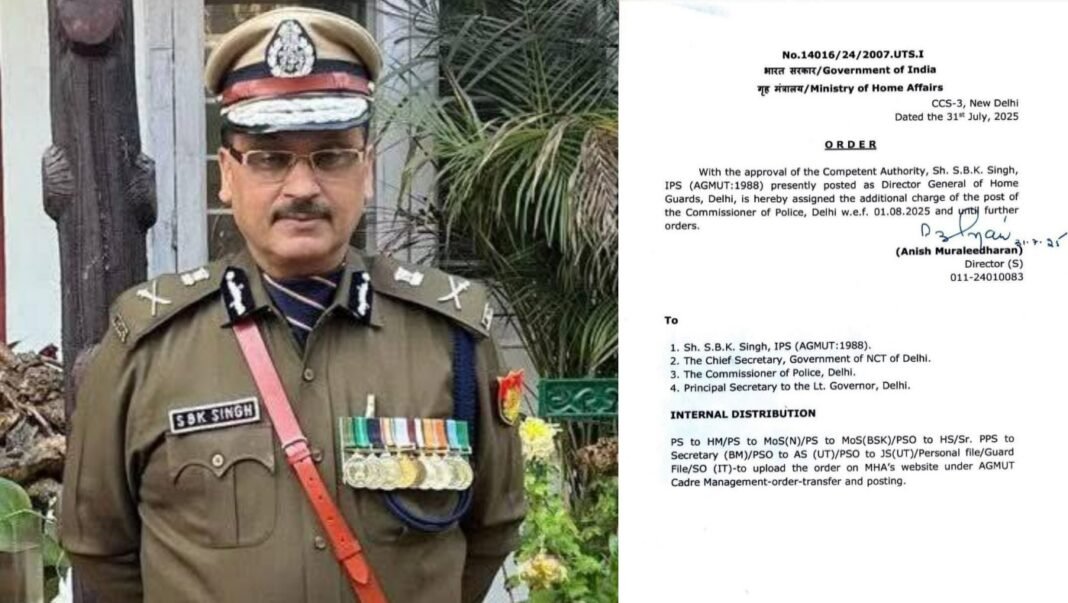Shashi Bhushan Kumar Singh to Lead Delhi Police Amid Critical Security Landscape
New Delhi: The Union Ministry of Home Affairs has appointed senior IPS officer Shashi Bhushan Kumar Singh as the new Commissioner of Delhi Police. Singh, a 1988-batch officer from the Arunachal Pradesh-Goa-Mizoram and Union Territories (AGMUT) cadre, will assume charge on August 1, 2025. He currently serves as the Director General of Home Guards in Delhi and will be taking over the reins from Sanjay Arora, a 1988-batch Tamil Nadu cadre officer.
Singh’s appointment comes at a time when the national capital is grappling with multiple layers of security threats, including increased drone activity, gang violence, and a surge in cybercrimes. With Independence Day around the corner, the new commissioner’s immediate challenge will be to ensure a secure and incident-free celebration, while also tackling the broader issues that plague law enforcement in the capital.
An alumnus of Sainik School Tilaiya in Hazaribagh, Jharkhand, Singh is widely respected for his sharp administrative acumen and balanced leadership style. His long-standing experience across various Union territories and in Delhi itself gives him an insider’s view of the city’s evolving security dynamics. Having held several critical postings in Delhi over the years, Singh is no stranger to the complexities of urban policing in one of the country’s most scrutinised regions.
The Ministry’s official notification stated that Singh’s appointment would be effective from August 1 and will continue “until further orders.” The move marks a return to the tradition of appointing AGMUT cadre officers to the top post, following a brief period where non-AGMUT officers held the position. Sanjay Arora, whom Singh replaces, was the third officer from outside the AGMUT cadre to lead Delhi Police, following Ajay Raj Sharma from the Uttar Pradesh cadre and Rakesh Asthana from the Gujarat cadre.
Sanjay Arora, who served previously as Director General of the Indo-Tibetan Border Police (ITBP), was known for his calm leadership during turbulent times. His tenure saw a renewed focus on community policing and modernization of the police force, with technology-driven initiatives and capacity building efforts being pushed forward. Under his watch, the force implemented several reforms aimed at improving public trust and responsiveness. However, no official announcement has been made regarding his next posting, though there is speculation about a central role in a national security agency.
Singh’s elevation comes at a time when Delhi Police is under pressure to step up its intelligence and counter-surveillance mechanisms, especially in light of evolving threats posed by drones and other aerial technologies. Intelligence inputs ahead of the August 15 celebrations have prompted multiple coordination meetings across law enforcement and intelligence agencies. Singh is expected to lead these efforts with a firm yet consultative approach, sources said.
In addition to the security build-up, Singh will also be dealing with ongoing concerns related to organized crime and digital offenses. The rapid rise in cybercrimes has led to a growing demand for specialised task forces, which Singh is likely to prioritize during his tenure. His previous experience in managing administrative functions and emergency response units may serve as a valuable asset in these efforts.
Political observers and policing experts see Singh’s appointment as a move aimed at ensuring continuity, given his existing familiarity with Delhi’s law and order machinery. His tenure at the Home Guards was marked by enhanced coordination between civic authorities and the police, especially during crisis situations such as the COVID-19 pandemic and urban disasters.
As he prepares to step into one of the most high-profile police positions in the country, expectations will be high. Singh’s track record, however, suggests a methodical and grounded approach to leadership—something many believe the force needs as it enters a new phase of security preparedness and public engagement.








